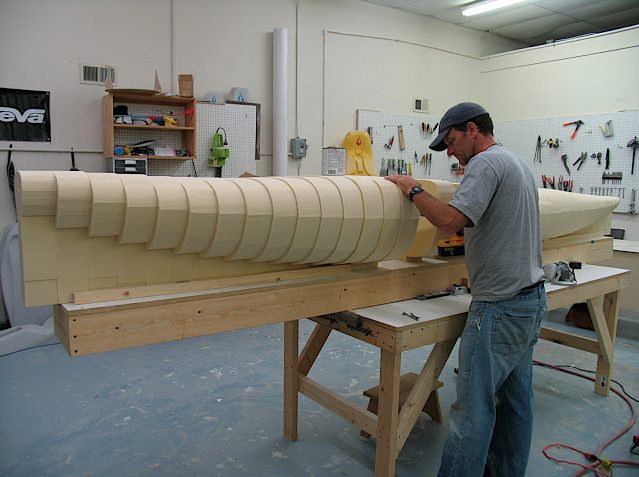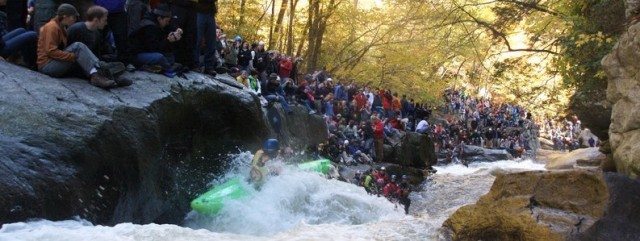BLISTER: So, you designed the Stinger. What design aspects make it stand apart from older long boats, and what separates it from other modern long boats like the Green Boat and Jackson Karma Unlimited?
Shane: The difference from the older boats is huge and it shows just how much we’ve learned about rocker. The older boats in general did not have a lot of rocker except for at the very ends. Newer boats vary, but the Stinger has a fairly aggressive, quick rise in the bow, but a very long and gradual rocker profile in the stern. This emphasizes speed and keeps the bow from rising up as you paddle forward hard.
The Stinger also has a flat center portion of the hull, which, because the boat is so long, keeps you up on the surface and makes it easier to turn than old long boats. The long, drawn out rocker in the stern also helps you to keep speed through holes.
In a short boat that you’d paddle today, if you have a lot of speed through a slide, the boat will rise up when you hit the bottom and you’d ride a wheelie for a little while. That doesn’t happen in the Stinger. It forces your speed forward rather than letting you rise up.

Ergonomics have also changed a lot because of increases in volume. Older boats were low in the knees and had awkward foot positions. The volume is a lot greater in these new boats, which makes them more comfortable and helps them resurface. We’ve also put a little bit of edge on the Stinger, which helps it turn. You can carve a really long line to maintain your speed through a turn.
So that’s what’s changed from older designs. As for what sets it apart from other new boats, the Stinger focuses solely on going fast. It’s designed with the cockpit slightly forward. When I first started making the boat, I made it as a balanced design. But as we paddled it, I realized that we could handle a longer, faster design, so I added 9-inches of length to the stern.
When you paddle a boat forward fast, the bow starts to come up out of the water and the stern goes down. So the more length you add to stern, the longer you make that waterline. Because the Stinger added all that length and kept the rocker low, as you start to paddle quickly forward, you engage more of the stern. Once you are at maximum speed, the whole stern is in the water, lengthening your waterline.
BLISTER: Several community members voiced concern over safety in the race because there’s no qualifier and because of some perceived increases in the number of crashes. The Green Race has an excellent safety record and very few incidents, but how does the race maintain that record going forward?
Shane: I think some of that discussion of the race getting more chaotic is incorrect. We had a lot of swims last year, but we’ve had a very low injury rate. We’ve consistently had a 30-37% growth in racers year to year, and that fresh blood keeps it alive.
It’s a great challenge and the attitude is that you are there just to place your time. You’re rewarded and are part of the group just by doing it. It isn’t about winning. Well, it is for the top guys, they’re definitely trying to win. But most folks are just trying to finish, beat their last time, or race with their buddies against the clock.
It makes me think of these Tough Mudder events, marathons, color runs, or adventure races. It’s the challenge and just being a part of it. It’s obviously a little more hard core level, but being a part of the event seems to be what people are really into and that’s what the Green Race does well as a grassroots event.
BLISTER: One final question—You’ve seen so many of these races. Do you have any advice for a paddler who wants to race someday, whether they’re an elite boater from far away, or someone who is still trying to step up their game? What’s it like to compete?
Shane: My advice is not to rush. Give yourself time to learn the lines. I do think it’s a great goal, but one that you have to work toward. You can’t expect it to happen right way. Getting to know the rapids intimately so you know every nook and cranny and so you know every plan A and every plan B is important.
What people don’t see is that the racers are doing other things to prepare. They’re biking, running, or doing other things to stay fit in order to compete. Paddling down with your friends is a whole different beast than lining up to paddle by yourself down a difficult stretch of river with a crowd yelling at you. You really are alone when you race. You never look back and you never see anyone in front of you. You’re paddling the river in a way that you almost never do—you are alone. It’s a pretty bizarre feeling to drop into big rapids with nobody specifically with you.
And then you come into Gorilla and there are hundreds of people watching you. Some folks say they never really hear the crowd, but I think that’s bullshit! You see ‘em and you hear ‘em cause they’re on top of you. It can either break your focus or it can help you fine tune it as you go through there. But as you come through Gorilla, you are really boofing into a stadium and it’s incredible. But then you come out of that scene and you are back to solo paddling for a few rapids. You’re all alone until the finish line.
It’s a crazy way to paddle, and the main thing I would say to people is to become very familiar with the river. Practice paddling at speed. If you’re traveling from abroad, you’ve got to get 10-14 runs in before you can get down the rapids knowing every line.
It is a great event and a great thing to be a part of.

